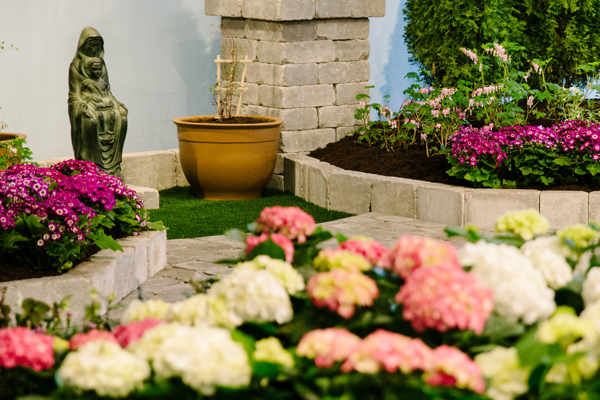Blogs

Learn and Reflect with the Mary's Gardens Exhibit
By Olivia Gillingham, Library Specialist in the Marian Library
Gardens have been considered ideal places for meditation and reflection throughout diverse cultural histories. The cloistered gardens of medieval monasteries and convents offered monks and nuns a peaceful outdoor space for contemplation while evoking a sort of earthly paradise through the profusion of plants and flowers, many of which often had religious symbolism. Even gardens without flowers, like Japanese rock gardens or contemporary labyrinth gardens, have been designed with the intent of aiding meditation and spiritual healing. Our own Mary garden, however, takes its cue from those earlier medieval cloister gardens with its cruciform shape created by perpendicular walkways, the statue of the Madonna and Child as the focal point, and the colorful blooms of flowers with Marian names.
A peaceful place where the connections to Mary are abundantly apparent, the garden is a perfect space to step away from the busyness of the day for some reflection and prayer. Starting today, March 28 through May 10, you can do just this by joining the weekly Rosary prayer led by students in the first-floor Mary garden from 10:00 to 10:20 p.m. Rosaries and instructions are available to borrow at any time during the library’s open hours, or you can bring your own.
The Mary’s Gardens exhibit offers a great opportunity to engage with not only the living garden, but also materials from the John Stokes and Mary’s Gardens Collection, and the beautiful new paintings by Holly Schapker, exhibited on the 7th floor. Already, multiple classes have taken advantage of the exhibit to utilize these fantastic resources, and show the scope of the exhibit’s application across schools and majors. A graphic design class plans to reuse plants from the first floor garden for a creation in St. Mary’s Hall, and a Women and Gender Studies student was able to utilize the Stokes collection for a project on feminism. The High and Late Medieval History class will also make use of exhibit materials next month.
No matter your major, we encourage everyone to visit the Mary’s Gardens exhibit. Whether for your studies, spiritual development, or simply as a way to escape spring showers and still see the flowers, you won’t want to miss it! go.udayton.edu/marysgardens
